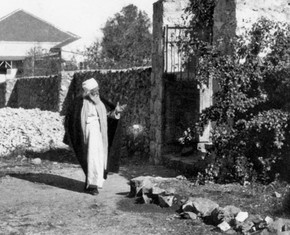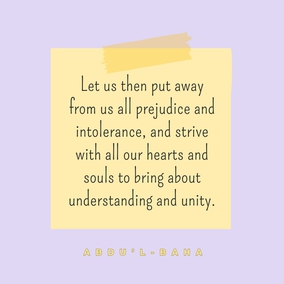The views expressed in our content reflect individual perspectives and do not represent the authoritative views of the Baha'i Faith.
Meditate then upon the utterance of one of the Prophets as He intimated to the souls of men, through veiled allusions and hidden symbols, the glad-tidings of the One Who was to come after Him, that thou mayest know of a certainty that their words are inscrutable to all save those who are endued with an understanding heart. He saith: “His eyes were as a flame of fire”, and “brass-like were His feet”, and “out of His mouth goeth a two-edged sword”. How could these words be literally interpreted? Were anyone to appear with all these signs, he would assuredly not be human. – Baha’u’llah, Gems of Divine Mysteries, p. 52.
Understanding prophecy requires a good grasp of figures of speech. The figurative, symbolic language used in prophecy employs five basic figures of speech (there are many), which we’ll review below, and then see how they appear in biblical prophecy, and how the Baha’i teachings interpret them. These five figures are:
1. Simile (a resemblance).
2. Metaphor (a representation).
3. Parable (a fable or an extended simile).
4. Allegory (an extended metaphor or story).
5. Symbol (a material thing that stands for a spiritual truth).
 You can see the distinction between a simile and metaphor in these two similar biblical verses: “All flesh is as grass,” from I Peter 1:24, is a simile, which compares one thing to another using the words “like” or “as.” “All flesh is grass,” the metaphor from Isaiah 40:6, drops the resemblance and becomes a direct representation.
You can see the distinction between a simile and metaphor in these two similar biblical verses: “All flesh is as grass,” from I Peter 1:24, is a simile, which compares one thing to another using the words “like” or “as.” “All flesh is grass,” the metaphor from Isaiah 40:6, drops the resemblance and becomes a direct representation.
A symbol—as in the words of Jesus from the Gospel of Thomas, Saying 7—reads like this: “Blessed is the lion which the man eats and the lion will become man; and cursed is the man whom the lion eats and the lion will become man.”
This “logion” or saying of Jesus, an enigmatic symbol both dark and deep, suggests that “lion” may represent the animal nature, or passions, of man.
Now let’s return to the question of how to understand prophecy by identifying figures of speech used in prophecy. Take Revelation 19:11–15, for example:
And I saw heaven opened, and behold a white horse; and he that sat upon him was called Faithful and True, and in righteousness he doth judge and make war.
His eyes were as a flame of fire, and on his head were many crowns; and he had a name written, that no man knew, but he himself.
And he was clothed with a vesture dipped in blood: and his name is called The Word of God.
And the armies which were in heaven followed him upon white horses, clothed in fine linen, white and clean.
And out of his mouth goeth a sharp sword, that with it he should smite the nations: and he shall rule them with a rod of iron: and he treadeth the winepress of the fierceness and wrath of Almighty God.
Here’s my figurative speech analysis of this mysterious passage:
1. Simile: “His eyes were as a flame of fire.”
2. Metaphor: “His name is called The Word of God”; “the winepress of the fierceness and wrath of Almighty God” (genitive metaphor).
3. Parable: “His eyes were as a flame of fire, and on his head were many crowns; and he had a name written, that no man knew, but he himself.”
4. Allegory: “And I saw heaven opened, and behold a white horse; and he that sat upon him was called Faithful and True, and in righteousness he doth judge and make war.”
5. Symbol: “heaven”; “white horse”; “he that sat upon him.”
The Baha’i interpretation of this passage, fascinating and deep, explains its mysteries:
I shall now briefly explain the true meaning of this utterance, that thou mayest discover its hidden mysteries and be of them that perceive…
Know then that He who uttered these words in the realms of glory meant to describe the attributes of the One Who is to come in such veiled and enigmatic terms as to elude the understanding of the people of error.
Now, when He saith: “His eyes were as a flame of fire”, He alludeth but to the keenness of sight and acuteness of vision of the Promised One, Who with His eyes burneth away every veil and covering, maketh known the eternal mysteries in the contingent world, and distinguisheth the faces that are obscured with the dust of hell from those that shine with the light of paradise…
As to the words “brass-like were His feet”, by this is meant His constancy upon hearing the call of God that commandeth Him: “Be thou steadfast as thou hast been bidden.” He shall so persevere in the Cause of God, and evince such firmness in the path of His might, that even if all the powers of earth and heaven were to deny Him, He would not waver in the proclamation of His Cause, nor flee from His command in the promulgation of His Laws. Nay rather, He will stand as firm as the highest mountains and the loftiest peaks. . . . Hast thou ever seen in this world brass stronger, or blade sharper, or mountain more unyielding than this?…
And further He saith: “Out of his mouth goeth a two-edged sword.” Know thou that since the sword is an instrument that divideth and cleaveth asunder, and since there proceedeth from the mouth of the Prophets and the Chosen Ones of God that which separateth the believer from the infidel and the lover from the beloved, this term hath been so employed, and apart from this dividing and separating no other meaning is intended. – Baha’u’llah, Gems of Divine Mysteries, pp. 53–56.
Let’s review the four steps to “Figuring Out Prophecy:”
Step 1: Exclude literal meaning.
Step 2: Identify figures of speech.
Step 3: Ascertain qualities represented.
Step 4: Apply to spiritual events.
Using this approach, here’s how Baha’u’llah has interpreted Revelations 19:11–15:
Step 1: “How could these words be literally interpreted?”
Step 2: “Meditate then upon the… veiled allusions and hidden symbols; …discover its hidden mysteries.”
Step 3: “Describe the attributes of the One Who is to come.”
Step 4. Recognize “the Promised One” – Baha’u’llah.
You May Also Like
Comments

















Why would the powers of heaven be set against the earnest?
Bahai love.
Paul